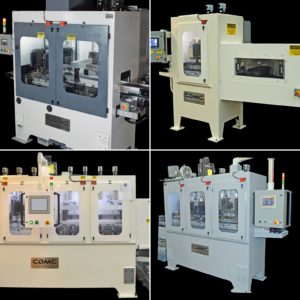Browse Categories

Browse Archives
Common Types of Deburring Machines

The deburring industry offers a number of solutions for deburring and parts finishing. Almost any type of need can be addressed by deburring machines. The markets and applications for these deburring machines are also wide in variety – including automotive, aerospace, defense, and, of course, manufacturing.
Most deburring solutions begin with a customer consultation that takes into consideration a number of highly-specialized requirements that must be met for a competent and complete solution to be suggested or custom-built. No application need is exactly like another. Given that there are a number of differences between the more common deburring machine solutions, the following is a listing of a number of deburring solutions and a description of their use.
Portable deburring machines come in a number of varieties. Some come on casters and some come on carts. Portable deburring machines are an excellent choice for shops that employ CNC mills or lathes. The portable deburring machine on casters can be maneuvered to accommodate finishing needs after the primary cutting is completed – right as the parts come off the mill or lathe.
The magnetic deburring machines offer an in-line, through-feed deburring process that is typically suited for higher production requirements. Traditionally, these magnetic deburring machines address flat parts that require deburring on both sides. A magnetic conveyor belt helps to keep parts in alignment as they are passed by both sets of brushes. As these deburring machines are capable of handling parts in quantity, an integrated coolant system keeps the system
cool and helps to prolong brush life. The magnetic deburring machines can typically handle parts up to 4” thick and at 6” in diameter.
The bevel gear deburring machine makes use of a single large-diameter nylon radial brush to deburr small bevel gears. Dual spindle models allow for the loading or unloading of a part while another part is under the deburring process. Again, an integrated coolant system comes standard.
A parallel-axis gear deburring machine is rugged, dependable, and efficient – a perfect deburring solution for a manufacturer with a number of different parts profiles that need to be stored and recalled when there is a call for a particular deburring need. The parallel-axis gear deburring machine is a deburring workhorse that can store hundreds of part profiles for recall. The parallel- axis gear deburring machine also features a zero set-up changeover system that eliminates most of the time required to switch from one type of part to another.
A ring gear deburring machine offers consistent quality in deburring a variety of parts sizes. The CDMC Model 1220, for example, deburrs ring gears up to 15” in diameter during a two-step process. The CDMC Model 9005 will deburr larger parts up to 24” in diameter. Like many of the other large deburring machines, these ring gear deburring machines feature an integrated coolant system as well.
